Reflections of a Police Psychologist

Third Edition-R
Jack A. Digliani, PhD, EdD is a licensed psychologist and a former deputy sheriff, police officer, and detective. He served as a law enforcement officer for the Laramie County, Wyoming Sheriff’s Office, the Cheyenne, Wyoming Police Department, and the Fort Collins, Colorado Police Services (FCPS). He was the FCPS Director of Human Services and police psychologist for the last 11 years of his FCPS police career. While in this position he provided psychological services to employees and their family, and clinically supervised the FCPS Peer Support Team.
Dr. Digliani also served as the police psychologist for the Loveland, Colorado Police Department (LPD) and the Larimer County. Colorado Sheriff’s Office (LCSO). During this period of service he provided psychological counseling services to department employees and their family. He was also the clinical supervisor of the agencies’ Peer Support Teams. He continues to serve LCSO as an adjunct psychologist. He has worked with numerous municipal, county, state, and federal law enforcement agencies. He specializes in police and trauma psychology, group interventions, and the development of police and other first-responder peer support teams. He was awarded the FCPS Medal of Merit, the LPD Special Recognition Award, the LPD Cornerstone Award, the LCSO Distinguished Service Medal, a Boulder County, Colorado Sheriff's Commendation, the Wyoming Highway Patrol Meritorious Conduct Award, and a Boulder, Colorado Police Department commendation for his work in police psychology.
Dr. Digliani is the author of numerous publications including Reflections of a Police Psychologist (now in Third Edition-R), Contemporary Issues in Police Psychology, Law Enforcement Peer Support Team Manual, Firefighter (also EMS and Civilian) Peer Support Team Manuals, Law Enforcement Critical Incident Handbook, Law Enforcement Marriage and Relationship Guidebook, and Emergency Services Dispatch Support Information Handbook. He is a contributor-writer of Colorado Revised Statutes (CRS) 13-90-107(m) Who may not testify without consent, the statute and paragraph which grants qualified law enforcement, firefighter, and other peer support team personnel specified confidentiality protection during peer support interactions. He is also the primary author of the peer support section of the Critical Incident Protocol of the 8th Judicial District of Colorado. In 2019, various components of his law enforcement officer Trauma Intervention Program were incorporated into CRS 16-2.5-403 Peace officer-involved shooting or fatal use of force policy (click here to view CRS 16-2.5-403)..
In 1990, Dr. Digliani created the Psychologist and Training/Recruit Officer Liaison (PATROL) program, a program designed to support new police officers and their families during academy and field training. This concept was later extended to the fire service. The Firefighter Recruit Support (FIRST) program supports firefighters and their family during recruit training. In 1992, Dr. Digliani developed the Freezeframe strategy for group critical incident resiliency debriefing.
As a result of his years of experience he conceptualized the police Option-funnel versus Threat-funnel, Level I and Level II peer support, Life-by-Design/Life-by-Default, the 2 and 2, the Proactive Annual Check-in, and the Comprehensive Model for Police Advanced Strategic Support (COMPASS). This strategic program was later extended to firefighters in the Comprehensive Model for Peer Advanced Strategic Support. COMPASS is a career-long psychological health and wellness strategy for police officers and firefighters. In 2013, Dr. Digliani developed the conceptions of primary and secondary danger. He then created the "Make it Safe" Police Officer Initiative, a 12-element strategy designed to reduce the secondary danger of policing. The Initiative was later adapted for firefighters and EMS personnel (See page 5). In 2015, he crafted the Peer Support Team Code of Ethical Conduct. In 2017, he developed the Peer Support Team Utilization and Outcome Survey.
Dr. Digliani is a guest lecturer in forensic and police psychology at Colorado State University and a Board of Directors Peer Support Advisor for the Badge of Life (www.badgeoflife.org)..He has consulted with many law enforcement and other first-responder agencies throughout the United States and internationally.
Dr. Digliani also served as the police psychologist for the Loveland, Colorado Police Department (LPD) and the Larimer County. Colorado Sheriff’s Office (LCSO). During this period of service he provided psychological counseling services to department employees and their family. He was also the clinical supervisor of the agencies’ Peer Support Teams. He continues to serve LCSO as an adjunct psychologist. He has worked with numerous municipal, county, state, and federal law enforcement agencies. He specializes in police and trauma psychology, group interventions, and the development of police and other first-responder peer support teams. He was awarded the FCPS Medal of Merit, the LPD Special Recognition Award, the LPD Cornerstone Award, the LCSO Distinguished Service Medal, a Boulder County, Colorado Sheriff's Commendation, the Wyoming Highway Patrol Meritorious Conduct Award, and a Boulder, Colorado Police Department commendation for his work in police psychology.
Dr. Digliani is the author of numerous publications including Reflections of a Police Psychologist (now in Third Edition-R), Contemporary Issues in Police Psychology, Law Enforcement Peer Support Team Manual, Firefighter (also EMS and Civilian) Peer Support Team Manuals, Law Enforcement Critical Incident Handbook, Law Enforcement Marriage and Relationship Guidebook, and Emergency Services Dispatch Support Information Handbook. He is a contributor-writer of Colorado Revised Statutes (CRS) 13-90-107(m) Who may not testify without consent, the statute and paragraph which grants qualified law enforcement, firefighter, and other peer support team personnel specified confidentiality protection during peer support interactions. He is also the primary author of the peer support section of the Critical Incident Protocol of the 8th Judicial District of Colorado. In 2019, various components of his law enforcement officer Trauma Intervention Program were incorporated into CRS 16-2.5-403 Peace officer-involved shooting or fatal use of force policy (click here to view CRS 16-2.5-403)..
In 1990, Dr. Digliani created the Psychologist and Training/Recruit Officer Liaison (PATROL) program, a program designed to support new police officers and their families during academy and field training. This concept was later extended to the fire service. The Firefighter Recruit Support (FIRST) program supports firefighters and their family during recruit training. In 1992, Dr. Digliani developed the Freezeframe strategy for group critical incident resiliency debriefing.
As a result of his years of experience he conceptualized the police Option-funnel versus Threat-funnel, Level I and Level II peer support, Life-by-Design/Life-by-Default, the 2 and 2, the Proactive Annual Check-in, and the Comprehensive Model for Police Advanced Strategic Support (COMPASS). This strategic program was later extended to firefighters in the Comprehensive Model for Peer Advanced Strategic Support. COMPASS is a career-long psychological health and wellness strategy for police officers and firefighters. In 2013, Dr. Digliani developed the conceptions of primary and secondary danger. He then created the "Make it Safe" Police Officer Initiative, a 12-element strategy designed to reduce the secondary danger of policing. The Initiative was later adapted for firefighters and EMS personnel (See page 5). In 2015, he crafted the Peer Support Team Code of Ethical Conduct. In 2017, he developed the Peer Support Team Utilization and Outcome Survey.
Dr. Digliani is a guest lecturer in forensic and police psychology at Colorado State University and a Board of Directors Peer Support Advisor for the Badge of Life (www.badgeoflife.org)..He has consulted with many law enforcement and other first-responder agencies throughout the United States and internationally.
Chapter titles of Reflections of a Police Psychologist (Third edition-R)
Chapter 1 The Transition Chapter 8 Coping with Death and Mourning
Chapter 2 Field Training and PATROL Chapter 9 Interacting with Persons that are Mentally Ill
Chapter 3 Police Stress and Occupational Health Chapter 10 Suicide and Police Officers
Chapter 4 Critical Incidents Chapter 11 Life After a Police Career
Chapter 5 Critical Incident Group Debriefings Chapter 12 Reflections of a Police Psychologist
Chapter 6 Peer Support and Police Peer Support Teams Appendices
Chapter 7 Police Marriage and Family
Reflections of a Police Psychologist (Third edition-R) is available at www.barnesandnoble.com
Chapter 1 The Transition Chapter 8 Coping with Death and Mourning
Chapter 2 Field Training and PATROL Chapter 9 Interacting with Persons that are Mentally Ill
Chapter 3 Police Stress and Occupational Health Chapter 10 Suicide and Police Officers
Chapter 4 Critical Incidents Chapter 11 Life After a Police Career
Chapter 5 Critical Incident Group Debriefings Chapter 12 Reflections of a Police Psychologist
Chapter 6 Peer Support and Police Peer Support Teams Appendices
Chapter 7 Police Marriage and Family
Reflections of a Police Psychologist (Third edition-R) is available at www.barnesandnoble.com
Contemporary Issues in Police Psychology
Contemporary Issues in Police Psychology: Police Peer Support Team Training and the Make it Safe Police Officer Initiative
 Click for PPSTT
Click for PPSTT
Contemporary Issues in Police Psychology addresses several timely topics in modern police psychology. It is written for police officers, those with an interest in policing, and trainers of police (and other) peer support teams. It includes a question-and-response discussion of issues relevant to police peer support, an enhanced outline of the Police Peer Support Team Training (PPSTT) program, an introduction to the innovative concepts of police physical/psychological primary danger and police secondary danger, and a description/implementation of the Make it Safe Police Officer Initiative. The enhanced outline of the PPSTT may be used as a structural model for qualified clinicians and law enforcement officers interested in training police peer support teams. To view the updated 2024 PPSTT program enhanced outline click on the book cover icon at left.
Contemporary Issues in Police Psychology is available at www.barnesandnoble.com
Contemporary Issues in Police Psychology is available at www.barnesandnoble.com
Police Physical-Psychological Primary Danger and Police Secondary Danger
The primary danger of policing has two components: (1) physical primary danger and (2) psychological primary danger.
Physical primary danger. The physical primary danger of policing is comprised of the inherent, potentially life-threatening risks of the job, such as working in motor vehicle traffic, emergency vehicle operation, representing a target for disgruntled persons, and confronting armed and violent individuals. One needs only to read a newspaper or watch a news program to understand the physical primary danger of policing.
Psychological primary danger. The psychological primary danger of policing is related to, but distinguishable from the physical primary danger of policing. The psychological primary danger of policing is represented in the increased probability that due to the nature of policing, officers will be exposed to critical incidents, work-related cumulative stress, and human tragedy. This higher probability of exposure results in an increased likelihood that officers will suffer psychological traumatization and stressor-related disorders. It is the increased likelihood of psychological traumatization and the increased likelihood of experiencing stressor-related disorders that comprises the psychological primary danger of policing. Another way of saying this is that the physical primary danger of policing constitutes a work environment that generates the psychological primary danger of policing.
Secondary danger. There is also an insidious and lesser known secondary danger of policing. The secondary danger of policing is often unspecified and seldom discussed. It is an artifact of the police culture and is frequently reinforced by police officers themselves. It is the idea that equates “asking for help” with “personal and professional weakness." Secondary danger has been implicated in perhaps the most startling of all police fatality statistics, the frequency of police officer suicide.
How serious is police secondary danger? So serious that some officers will choose suicide over asking for help.
For more information click here.
Law enforcement is not alone. There is a similar secondary danger in numerous other occupations, including firefighting, emergency service dispatching, airplane piloting, the practice of medicine, and military service. (For more information see Chapter 3 of Contemporary Issues in Police Psychology)
Physical primary danger. The physical primary danger of policing is comprised of the inherent, potentially life-threatening risks of the job, such as working in motor vehicle traffic, emergency vehicle operation, representing a target for disgruntled persons, and confronting armed and violent individuals. One needs only to read a newspaper or watch a news program to understand the physical primary danger of policing.
Psychological primary danger. The psychological primary danger of policing is related to, but distinguishable from the physical primary danger of policing. The psychological primary danger of policing is represented in the increased probability that due to the nature of policing, officers will be exposed to critical incidents, work-related cumulative stress, and human tragedy. This higher probability of exposure results in an increased likelihood that officers will suffer psychological traumatization and stressor-related disorders. It is the increased likelihood of psychological traumatization and the increased likelihood of experiencing stressor-related disorders that comprises the psychological primary danger of policing. Another way of saying this is that the physical primary danger of policing constitutes a work environment that generates the psychological primary danger of policing.
Secondary danger. There is also an insidious and lesser known secondary danger of policing. The secondary danger of policing is often unspecified and seldom discussed. It is an artifact of the police culture and is frequently reinforced by police officers themselves. It is the idea that equates “asking for help” with “personal and professional weakness." Secondary danger has been implicated in perhaps the most startling of all police fatality statistics, the frequency of police officer suicide.
How serious is police secondary danger? So serious that some officers will choose suicide over asking for help.
For more information click here.
Law enforcement is not alone. There is a similar secondary danger in numerous other occupations, including firefighting, emergency service dispatching, airplane piloting, the practice of medicine, and military service. (For more information see Chapter 3 of Contemporary Issues in Police Psychology)
The Make it Safe Police Officer Initiative, Police Secondary Danger, and Police Suicide

Click for printer friendly version
The Make it Safe Police Officer Initiative – Make it safe for officers to ask for psychological support
The Make it Safe Police Officer Initiative is comprised of 12 elements designed to reduce the secondary danger of policing by making it safe for police officers to ask for psychological support.
The Make it Safe Police Officer Initiative seeks to:
(1) make it personally and professionally acceptable for officers to engage peer and professional psychological support services without fear of agency or peer reprisal or ridicule.
(2) reduce officer fears about asking for psychological support when confronting potentially overwhelming job or other life difficulties.
(3) change organizational climates that discourage officers from seeking psychological help by reducing explicit and implicit organizational messages that imply asking for help is indicative of personal and professional weakness.
(4) alter the profession-wide law enforcement culture that generally views asking for psychological help as a personal or professional weakness.
(5) improve the career-long psychological wellness of officers by encouraging police agencies to adopt long-term and comprehensive officer-support strategies such as the Comprehensive Model for Police Advanced Strategic Support.
Twelve elements of the Make it Safe Police Officer Initiative
The Make it Safe Initiative Police Officer Initiative encourages:
(1) every officer to "self-monitor" and to take personal responsibility for their mental wellness.
(2) every officer to seek psychological support when confronting potentially overwhelming difficulties (officers do not have to "go it alone").
(3) every officer to diminish the sometimes deadly effects of secondary danger by reaching out to other officers known to be facing difficult circumstances.
(4) veteran and ranking officers to use their status to help reduce secondary danger (veteran and ranking officers can reduce secondary danger by openly discussing it, appropriately sharing selected personal experiences, avoiding the use of pejorative terms to describe officers seeking or engaging psychological support, and talking about the acceptability of seeking psychological support when confronting stressful circumstances).
(5) law enforcement administrators to better educate themselves about the nature of secondary danger and to take the lead in secondary danger reduction. (6) law enforcement administrators to issue a departmental memo encouraging officers to engage psychological support services when confronting potentially overwhelming stress (the memo should include information about confidentiality and available support resources).
(7) basic training in stress management, stress inoculation, critical incidents, post-traumatic stress, police family dynamics, substance use and addiction, and the warning signs of depression and suicide.
(8) the development of programs that engage preemptive, early-warning, and periodic department-wide officer support interventions (for example, proactive annual check in, “early warning” policies designed to support officers displaying signs of stress, and regularly scheduled stress inoculation and critical incident stressor management training).
(9) law enforcement agencies to initiate incident-specific protocols to support officers and their families when officers are involved in critical incidents.
(10) law enforcement agencies to create appropriately structured, properly trained, and clinically supervised peer support teams.
(11) law enforcement agencies to provide easy and confidential access to counseling and specialized police psychological support services.
(12) police officers at all levels of the organization to enhance the agency climate so that others are encouraged to ask for help when experiencing psychological or emotional difficulties instead of keeping and acting out a deadly secret.
The Make it Safe Police Officer Initiative is dedicated to making it safe for officers to request and engage appropriate psychological support when dealing with difficult circumstances. An officer does not need to be suicidal, have an alcohol or other substance use problem, or be experiencing the emotional aftermath of a critical incident to benefit from this change in the police culture. The men and women of law enforcement need to re-think what it means to be a police officer. Officers should be able to ask for help without fear of negative career consequences and without feeling that asking for help is a personal and professional weakness. Take a positive step forward - become part of the Make it Safe Police Officer Initiative today.
If law enforcement officers wish to do the best for themselves and other officers, it’s time to make a change. It's time to make a difference.
The 12 elements of the Make it Safe Police Officer Initiative can be utilized in any occupational environment where secondary danger is a factor.
The Make it Safe Police Officer Initiative is comprised of 12 elements designed to reduce the secondary danger of policing by making it safe for police officers to ask for psychological support.
The Make it Safe Police Officer Initiative seeks to:
(1) make it personally and professionally acceptable for officers to engage peer and professional psychological support services without fear of agency or peer reprisal or ridicule.
(2) reduce officer fears about asking for psychological support when confronting potentially overwhelming job or other life difficulties.
(3) change organizational climates that discourage officers from seeking psychological help by reducing explicit and implicit organizational messages that imply asking for help is indicative of personal and professional weakness.
(4) alter the profession-wide law enforcement culture that generally views asking for psychological help as a personal or professional weakness.
(5) improve the career-long psychological wellness of officers by encouraging police agencies to adopt long-term and comprehensive officer-support strategies such as the Comprehensive Model for Police Advanced Strategic Support.
Twelve elements of the Make it Safe Police Officer Initiative
The Make it Safe Initiative Police Officer Initiative encourages:
(1) every officer to "self-monitor" and to take personal responsibility for their mental wellness.
(2) every officer to seek psychological support when confronting potentially overwhelming difficulties (officers do not have to "go it alone").
(3) every officer to diminish the sometimes deadly effects of secondary danger by reaching out to other officers known to be facing difficult circumstances.
(4) veteran and ranking officers to use their status to help reduce secondary danger (veteran and ranking officers can reduce secondary danger by openly discussing it, appropriately sharing selected personal experiences, avoiding the use of pejorative terms to describe officers seeking or engaging psychological support, and talking about the acceptability of seeking psychological support when confronting stressful circumstances).
(5) law enforcement administrators to better educate themselves about the nature of secondary danger and to take the lead in secondary danger reduction. (6) law enforcement administrators to issue a departmental memo encouraging officers to engage psychological support services when confronting potentially overwhelming stress (the memo should include information about confidentiality and available support resources).
(7) basic training in stress management, stress inoculation, critical incidents, post-traumatic stress, police family dynamics, substance use and addiction, and the warning signs of depression and suicide.
(8) the development of programs that engage preemptive, early-warning, and periodic department-wide officer support interventions (for example, proactive annual check in, “early warning” policies designed to support officers displaying signs of stress, and regularly scheduled stress inoculation and critical incident stressor management training).
(9) law enforcement agencies to initiate incident-specific protocols to support officers and their families when officers are involved in critical incidents.
(10) law enforcement agencies to create appropriately structured, properly trained, and clinically supervised peer support teams.
(11) law enforcement agencies to provide easy and confidential access to counseling and specialized police psychological support services.
(12) police officers at all levels of the organization to enhance the agency climate so that others are encouraged to ask for help when experiencing psychological or emotional difficulties instead of keeping and acting out a deadly secret.
The Make it Safe Police Officer Initiative is dedicated to making it safe for officers to request and engage appropriate psychological support when dealing with difficult circumstances. An officer does not need to be suicidal, have an alcohol or other substance use problem, or be experiencing the emotional aftermath of a critical incident to benefit from this change in the police culture. The men and women of law enforcement need to re-think what it means to be a police officer. Officers should be able to ask for help without fear of negative career consequences and without feeling that asking for help is a personal and professional weakness. Take a positive step forward - become part of the Make it Safe Police Officer Initiative today.
If law enforcement officers wish to do the best for themselves and other officers, it’s time to make a change. It's time to make a difference.
The 12 elements of the Make it Safe Police Officer Initiative can be utilized in any occupational environment where secondary danger is a factor.
The Make it Safe Police Officer Initiative Powerpoint Presentation
The Make it Safe Police Officer Initiative and Concerns for Fitness for Duty

Asking for help does not mean "unfit for duty"
Some officers will not ask for psychological help even when they think they should because they have concerns about being "found out" and perceived as "unfit for duty". Although it is possible for police officers to develop psychological symptoms serious enough to become incapable of safely performing at work, there is no comparison between asking for help and being unfit for duty. Seeking appropriate support and intervention for any reason, be it physical, psychological, emotional, social, or substance-use related does not automatically make an officer unfit for duty. The fear of being found out and perceived as unfit for duty is a manifestation of police secondary danger. Secondary danger is what the Make it Safe Police Officer Initiative is designed to address.
Implementing The Make it Safe Police Officer Initiative

12 Elements
Initiative Implementation Action Plan: (1) Learn about the Initiative, (2) bring it to the attention of administrators/staff, (3) become an advocate, (4) work with staff to address concerns, (5) move methodically - first implement the elements most easily accomplished, (6) be patient, maintain effort, (7) contact Jack A. Digliani if you get stuck or have questions.
Implementing the Make it Safe Police Officer Initiative is not difficult. The elements of the Initiative are easily implemented by initiating processes, strategies, and programs already well known to law enforcement agencies.
The Initiative is not an “all or nothing” proposition. Various elements of the Initiative can be implemented independently of one another. Although it is best to move forward with the entire Initiative, a partial implementation is better than no implementation.
There is no “one right way” to implement any element of the Initiative. Be creative. Make the Make it Safe Police Officer Initiative work for you. For some thoughts about implementing the Initiative, click on this button:
Implementing the Make it Safe Police Officer Initiative is not difficult. The elements of the Initiative are easily implemented by initiating processes, strategies, and programs already well known to law enforcement agencies.
The Initiative is not an “all or nothing” proposition. Various elements of the Initiative can be implemented independently of one another. Although it is best to move forward with the entire Initiative, a partial implementation is better than no implementation.
There is no “one right way” to implement any element of the Initiative. Be creative. Make the Make it Safe Police Officer Initiative work for you. For some thoughts about implementing the Initiative, click on this button:
Law Enforcement Critical Incident Handbook
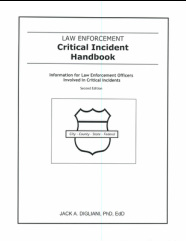
Click for Critical Incident Handbook
The Law Enforcement Critical Incident Handbook (Edition 3.1) is designed to provide concise and practical information to officers that have recently or historically experienced a critical incident. Handbook topics include:
The Handbook and the Law Enforcement Peer Support Team Manual are companion publications to Reflections of a Police Psychologist.
- Critical and Traumatic Incidents
- Critical Incident Information
- Posttraumatic Stress, PTSD, and Acute Stress Disorder
- Traumatic Stress: Shock, Impact, and Recovery – Stronger and Smarter
- Option Funnel verses Threat Funnel
- Critical Incident Issues, Strategies, and Concepts
- Incident Debriefing Information
- Danger, Unavoidable Stressors, and Confrontation
- Suicide by Cop
- Witness to Suicide
- Police Spouse Anxiety and Critical Incidents
- 25 Suggestions and Considerations for Officers Involved in Critical Incidents
- Officers and Spouses: Critical Incident Information
The Handbook and the Law Enforcement Peer Support Team Manual are companion publications to Reflections of a Police Psychologist.
The Three "Seconds" of Policing

Secondary Danger, Secondary Injury, and Secondary Trauma
The secondary danger of policing is the idea that equates “asking for help” with “personal and professional weakness”. Secondary injury is the harm that can be caused to officers when they are poorly treated following involvement in a critical incident. Secondary trauma — also known as vicarious trauma — refers to the indirect traumatization that can occur when a person is exposed to others who have been directly traumatized. Secondary trauma is a real concern for the spouses and family members of officers that have been involved in a critical incident, as well as previously non-traumatized officers and others participating in departmental critical incident debriefings.
The secondary danger of policing is the idea that equates “asking for help” with “personal and professional weakness”. Secondary injury is the harm that can be caused to officers when they are poorly treated following involvement in a critical incident. Secondary trauma — also known as vicarious trauma — refers to the indirect traumatization that can occur when a person is exposed to others who have been directly traumatized. Secondary trauma is a real concern for the spouses and family members of officers that have been involved in a critical incident, as well as previously non-traumatized officers and others participating in departmental critical incident debriefings.
Law Enforcement Peer Support Team Manual - Edition 9.0
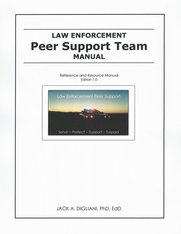
Click for Manual Edition 9.0
Police officers have supported one another since the inception of police forces. In the early years when police officers experienced emotional difficulties or troubling stressors, whether or not work related, they could always rely on the traditional B and B (booze and buddies) for solace. As you might expect, the results produced by the B and B method of stress management were sometimes less than desirable. Although booze and buddies still exist today, police officers now have several alternatives for assistance when dealing with stress-related difficulties. In many contemporary police agencies, these alternatives include the option of working with members of the department’s peer support team.
Police peer support teams have proven their value and have demonstrated their effectiveness for many years. They have established their place in the police mindset and have become an integral part of many law enforcement agencies.
Some police administrators do not recognize the need for peer support teams. This is because most agency employees (1) have access to a jurisdiction-wide employee assistance program (EAP) and (2) most agency health insurance benefit plans include a provision for psychological counseling. The availability of EAP and health plan psychological counseling for police officers represents a significant advancement in the delivery of counseling services. However for officers, EAPs and health plan counseling, although helpful, appear insufficient. They are helpful in that they are utilized by some officers who might not otherwise seek assistance. They are insufficient in that despite their availability, they do not and cannot meet the needs of many police officers.
Peer support teams occupy a support niche that cannot be readily filled by either an EAP, health plan provisions, or a police psychologist. If an agency wants to do the best it can to support its officers, a peer support team is necessary. Incidentally, a peer support team is one of the most valued resources for a police psychologist - many police psychologist counseling and preemptive intervention programs are designed to incorporate the efficacy of peer support.
If you are reading this as a member of a police peer support team, your agency has recognized the value of peer support. This means that your department has endorsed the principles of peer support and has willingly committed resources to make peer support available. As a peer support team member, you recognize this commitment and have assumed the responsibility to function within the parameters of your agency’s peer support team policy, operational guidelines, and training. If you are reading this and your agency does not have a peer support team, I encourage you to initiate a discussion about developing one. With appropriate member selection, training, and ongoing clinical advisement or supervision, a peer support team can become an invaluable asset to any law enforcement agency. To view and download the most recent edition of the Law Enforcement Peer Support Team Manual click on the Manual icon.
Colorado Revised Statutes (C.R.S.) 13-90-107(m). The Law Enforcement Peer Support Team Manual (Edition 9.0) includes C.R.S. 13-90-107(m) (2024) (p.17). Subsection (m) of C.R.S. 13-90-107 Who may not testify without consent was enacted into Colorado law in 2005. It created the first-ever statutory confidentiality privilege for Colorado police and fire peer support team members. With the passage of C.R.S. 13-90-107(m), Colorado became the fourth state to grant a degree of privileged communication to specified peer support teams. Subsection (m) was amended in 2013 to include “emergency medical service provider or rescue unit peer support team member.” In 2017, C.R.S. 13-90-107(m). was again amended to remove the restrictive “individual interactions" provision. In 2022, district attorney and public defender peer support teams were added to those specified in the statute. In 2024, it was amended to consolidate peer support team paragraphs, clarify the “without consent” provision for recipients of group peer support, and define “group peer support team services.” To view C.R.S. 13-90-107(m) (2024) click here.
Firefighter Peer Support Team Manual, EMS Peer Support Team Manual, and
Emergency Services Dispatch Support Information Handbook are available on website Page 5.
Police peer support teams have proven their value and have demonstrated their effectiveness for many years. They have established their place in the police mindset and have become an integral part of many law enforcement agencies.
Some police administrators do not recognize the need for peer support teams. This is because most agency employees (1) have access to a jurisdiction-wide employee assistance program (EAP) and (2) most agency health insurance benefit plans include a provision for psychological counseling. The availability of EAP and health plan psychological counseling for police officers represents a significant advancement in the delivery of counseling services. However for officers, EAPs and health plan counseling, although helpful, appear insufficient. They are helpful in that they are utilized by some officers who might not otherwise seek assistance. They are insufficient in that despite their availability, they do not and cannot meet the needs of many police officers.
Peer support teams occupy a support niche that cannot be readily filled by either an EAP, health plan provisions, or a police psychologist. If an agency wants to do the best it can to support its officers, a peer support team is necessary. Incidentally, a peer support team is one of the most valued resources for a police psychologist - many police psychologist counseling and preemptive intervention programs are designed to incorporate the efficacy of peer support.
If you are reading this as a member of a police peer support team, your agency has recognized the value of peer support. This means that your department has endorsed the principles of peer support and has willingly committed resources to make peer support available. As a peer support team member, you recognize this commitment and have assumed the responsibility to function within the parameters of your agency’s peer support team policy, operational guidelines, and training. If you are reading this and your agency does not have a peer support team, I encourage you to initiate a discussion about developing one. With appropriate member selection, training, and ongoing clinical advisement or supervision, a peer support team can become an invaluable asset to any law enforcement agency. To view and download the most recent edition of the Law Enforcement Peer Support Team Manual click on the Manual icon.
Colorado Revised Statutes (C.R.S.) 13-90-107(m). The Law Enforcement Peer Support Team Manual (Edition 9.0) includes C.R.S. 13-90-107(m) (2024) (p.17). Subsection (m) of C.R.S. 13-90-107 Who may not testify without consent was enacted into Colorado law in 2005. It created the first-ever statutory confidentiality privilege for Colorado police and fire peer support team members. With the passage of C.R.S. 13-90-107(m), Colorado became the fourth state to grant a degree of privileged communication to specified peer support teams. Subsection (m) was amended in 2013 to include “emergency medical service provider or rescue unit peer support team member.” In 2017, C.R.S. 13-90-107(m). was again amended to remove the restrictive “individual interactions" provision. In 2022, district attorney and public defender peer support teams were added to those specified in the statute. In 2024, it was amended to consolidate peer support team paragraphs, clarify the “without consent” provision for recipients of group peer support, and define “group peer support team services.” To view C.R.S. 13-90-107(m) (2024) click here.
Firefighter Peer Support Team Manual, EMS Peer Support Team Manual, and
Emergency Services Dispatch Support Information Handbook are available on website Page 5.
Critical Incident Management, Return-to Duty Protocol, and Graded Re-entry to Full Duty

Critical Incident Management, Return-to-Duty Protocol, and Graded Re-entry to Full Duty
Critical incident management information and a recommended Return-to-Duty Protocol are included in the Law Enforcement Peer Support Team Manual. A graded re-entry to full duty is part of the Return-to-Duty Protocol. The graded re-entry component of the Return-to-Duty Protocol is specifically designed to best meet the assessed needs of involved personnel. To view critical incident management information and a recommended return-to-duty protocol click here. To view an actual graded re-entry to full duty click here.
Critical incident management information and a recommended Return-to-Duty Protocol are included in the Law Enforcement Peer Support Team Manual. A graded re-entry to full duty is part of the Return-to-Duty Protocol. The graded re-entry component of the Return-to-Duty Protocol is specifically designed to best meet the assessed needs of involved personnel. To view critical incident management information and a recommended return-to-duty protocol click here. To view an actual graded re-entry to full duty click here.
Law Enforcement Critical Incident Information Booklet
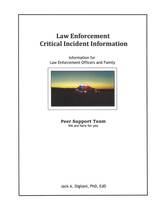 LE Critical Incident Information
LE Critical Incident Information
The Law Enforcement Critical Incident Information booklet is designed for distribution to officers and family members. It may be helpful during and following a critical incident support group meeting or debriefing. It is a compilation of several specialized articles that appear in the Law Enforcement Peer Support Team Manual, the Law Enforcement Critical Incident Handbook, and the Law Enforcement Marriage and Relationship Guidebook.
The booklet can also be distributed for training or information dissemination purposes.
Click on the "LE Critical Incident Information" icon to view and download the Law Enforcement Critical Incident Information booklet.
Psychologist And Training/Recruit Officer Liaison (PATROL)
 Click for the PATROL Program
Click for the PATROL Program
The Psychologist And Training/Recruit Officer Liaison program involves the police psychologist with police recruits early in police academy training. PATROL consists of: (1) a day Orientation during academy training and (2) a confidential meeting between the psychologist and recruit officer during each of the recruit's field training phases.
The PATROL program is proactive. It is designed to support recruit officers during training and before difficulties arise. One of the most significant positive secondary effects of the PATROL program has been the reduction of perceived stigma associated with visiting and interacting with the department psychologist.
PATROL was created in 1990 and originally designed as an ancillary component of the Field Training Officer (FTO) program. However, PATROL is readily adaptable to the Police Training Officer (PTO) program and can be integrated into any model of police officer field training.
PATROL is flexible and can be modified to meet the needs and available resources of any police agency. Senior officers, peer mentors, FTOs not involved in the recruit's field training, members of the peer support team, and Employee Assistance Program counselors may be utilized for PATROL in agencies without a staff psychologist. Click on the PATROL program police vehicle icon to view and download a brief summary and additional features of the PATROL program.
The PATROL program is proactive. It is designed to support recruit officers during training and before difficulties arise. One of the most significant positive secondary effects of the PATROL program has been the reduction of perceived stigma associated with visiting and interacting with the department psychologist.
PATROL was created in 1990 and originally designed as an ancillary component of the Field Training Officer (FTO) program. However, PATROL is readily adaptable to the Police Training Officer (PTO) program and can be integrated into any model of police officer field training.
PATROL is flexible and can be modified to meet the needs and available resources of any police agency. Senior officers, peer mentors, FTOs not involved in the recruit's field training, members of the peer support team, and Employee Assistance Program counselors may be utilized for PATROL in agencies without a staff psychologist. Click on the PATROL program police vehicle icon to view and download a brief summary and additional features of the PATROL program.
Assumption of Possible Threat - Assumption of Safety

Law enforcement officers work in an occupational world of assumption of possible threat, whereas most others work and live in a world of assumption of safety. This distinction is one of the fundamental differences between law enforcement and most other occupations. Officers must assume possible threat in nearly all policing interactions to avoid being harmed or killed due to complacency.
To increase the safety margin of officers, officers are trained to maintain a higher level of awareness and to act when possible threat becomes perceived actual threat.
To increase the safety margin of officers, officers are trained to maintain a higher level of awareness and to act when possible threat becomes perceived actual threat.
The Two-and-Two
 The 2 and 2
The 2 and 2
The Two-and-Two (2 and 2) is a simple way to characterize an anxiety coping strategy that has proven useful in the management of the reactivity that sometimes follows the exposure to a critical incident. The first "2" is "I know what this is, I know what to do about it". The second "2" is "stronger and smarter".
The 2 and 2 works like this: When a person experiences anxiety upon exposure to a critical incident-associated personal or environmental trigger, he or she quickly brings to mind the first "2" - "I know what this is, I know what to do about it. This is a current response to something connected to my past. I am not confronting danger now, therefore I do not need this feeling. I need to engage my anxiety coping mechanisms." (The person then engages previously learned anxiety management techniques). As anxiety management techniques are being utilized, the person accesses the cognitive notion of becoming stronger and smarter (because the alternatives are unacceptable). When used simultaneously, each "2" of the 2 and 2 combine to comprise a simple, yet powerful cognitive, emotional, behavioral, and physiological tool to manage post-traumatic stress and anxiety.
The 2 and 2 works like this: When a person experiences anxiety upon exposure to a critical incident-associated personal or environmental trigger, he or she quickly brings to mind the first "2" - "I know what this is, I know what to do about it. This is a current response to something connected to my past. I am not confronting danger now, therefore I do not need this feeling. I need to engage my anxiety coping mechanisms." (The person then engages previously learned anxiety management techniques). As anxiety management techniques are being utilized, the person accesses the cognitive notion of becoming stronger and smarter (because the alternatives are unacceptable). When used simultaneously, each "2" of the 2 and 2 combine to comprise a simple, yet powerful cognitive, emotional, behavioral, and physiological tool to manage post-traumatic stress and anxiety.
Comprehensive Model for Police Advanced Strategic Support (COMPASS)

Helping officers to find their way
The Comprehensive Model for Police Advanced Strategic Support begins with the organizational climate and pre-hire psychological assessment. It continues with career-long support considerations that extend beyond retirement.
COMPASS is flexible. Law enforcement agencies can modify COMPASS to best provide comprehensive officer-support within available programs and resources.
A graphic outline of COMPASS is included in Contemporary Issues in Police Psychology, the Law Enforcement Critical Incident Handbook, and the Law Enforcement Peer Support Team Manual. Click on the compass icon at left to view the COMPASS graphic outline.
COMPASS is flexible. Law enforcement agencies can modify COMPASS to best provide comprehensive officer-support within available programs and resources.
A graphic outline of COMPASS is included in Contemporary Issues in Police Psychology, the Law Enforcement Critical Incident Handbook, and the Law Enforcement Peer Support Team Manual. Click on the compass icon at left to view the COMPASS graphic outline.
Proactive Annual Check In (PAC)
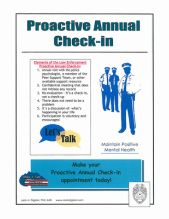
Click for PAC Poster
The Proactive Annual Check-In provides police officers and other agency employees with a confidential setting within which to share information about current life circumstances. It is a proactive program designed to offer a positive exchange of thoughts, ideas, and information.
Elements of the Proactive Annual Check-In:
(1) Annual visit with the staff psychologist, a member of the Peer Support Team, department Chaplain, private counselor, or other support resource, (2) Confidential meeting that does not initiate any record, (3) No evaluation - It’s a check-in, not a check-up, (4) There does not need to be a problem, (5) It’s a discussion of what’s happening in your life, 6) Participation is voluntary* and encouraged.
*Variations of PAC - In an effort to enhance employee wellness, some law enforcement agencies have made PAC meetings mandatory. Other agencies offer incentives for voluntary participation, such as a "day off" in exchange for an hour of participation. Still others, have moved to a "semi-annual" voluntary check-in, with incentives to participate every six months. When participation is mandatory or there are incentives, confidentiality issues must be addressed.
Agencies can readily implement the Proactive Annual Check-in program by utilizing currently available support resources.
Disseminate PAC program information by downloading, printing, and displaying
the PAC poster, available by clicking on the "PAC Poster" icon.
Elements of the Proactive Annual Check-In:
(1) Annual visit with the staff psychologist, a member of the Peer Support Team, department Chaplain, private counselor, or other support resource, (2) Confidential meeting that does not initiate any record, (3) No evaluation - It’s a check-in, not a check-up, (4) There does not need to be a problem, (5) It’s a discussion of what’s happening in your life, 6) Participation is voluntary* and encouraged.
*Variations of PAC - In an effort to enhance employee wellness, some law enforcement agencies have made PAC meetings mandatory. Other agencies offer incentives for voluntary participation, such as a "day off" in exchange for an hour of participation. Still others, have moved to a "semi-annual" voluntary check-in, with incentives to participate every six months. When participation is mandatory or there are incentives, confidentiality issues must be addressed.
Agencies can readily implement the Proactive Annual Check-in program by utilizing currently available support resources.
Disseminate PAC program information by downloading, printing, and displaying
the PAC poster, available by clicking on the "PAC Poster" icon.
Peer Support and Police Peer Support Teams
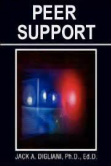
Power of the Peer
Peer support differs from counseling and psychotherapy. Peer support is a non-professional supportive interaction, whereas counseling and psychotherapy traditionally involve a professional relationship with a licensed clinician. Therefore, peer support is best conceptualized as a non-professional interpersonal interaction wherein: (1) a person attempts to assist another person with a stressful circumstance, and (2) the person providing support shares some common background, experience, condition, or history with the person he or she is attempting to help.
Level I and Level II Peer Support
Level I peer support: There are two levels of peer support. Level I peer support consists of the support found in the everyday positive interactions of friends, co-workers, and others that have some peer status. Nearly everyone, at one time or another, has been the provider and the recipient of this type of peer support. Level I peer support has a long history and can be thought of as “traditional” peer support. Level II peer support is similar to Level I, but Level II peer support includes several important components that are not present, or not necessarily present, in Level I. This makes Level II peer support interactions different from the Level I support that can come from "friends talking."
Level II peer support: (1) Level II peer support is provided by members of an agency-recognized peer support team functioning within state statute and/or department policy and operational guidelines, (2) Level II peer support is provided by persons trained in peer support, (3) Level II peer support interactions are characterized by elements of functional relationships which encourage exploration, empowerment, and positive change, (4) Advice giving is avoided in Level II peer support - independent decision making is encouraged, (5) Level II peer support is guided by ethical and conceptual parameters – this makes it different than just “friends talking,” (6) Level II peer support has positive outcomes as its goal – this is not always the case in Level I peer support interactions, (7) Peer support team members are clinically advised or supervised by a licensed mental health professional - this provides a “ladder of escalation” if consultation or referral is needed. A structured ladder of escalation is not available in Level I interactions, and (8) Level II peer support, while non-judgmental, includes a safety assessment – it has an evaluative component. If a peer support team member assesses that the recipient of peer support is dealing with an issue that exceeds the parameters of peer support or if it is assessed that the recipient is or may be overly stressed, depressed, or suicidal, the peer support team member is trained to act upon the assessment. This is accomplished by providing information about available resources, making appropriate referrals, moving up the ladder of escalation, or initiating emergency intervention.
Peer support team members capable of providing Level II peer support may continue to provide Level I peer support. Level I peer support occurs when peer support team members are not acting in their peer support team member role. However, when peer support team members are not acting in their peer support team role, the confidentiality privileges afforded to peer support team members during peer support interactions do not apply. Level II peer support, like Level I, may consist of a one-time contact or ongoing meetings.
Why Peer Support? When Peer Support?
Some police officers and administrators are unclear about the role of a peer support team, especially considering that most modern-day police jurisdictions provide counseling services through health insurance plans and Employee Assistance Programs (EAP). It is not surprising that some police administrators ask, “With employee insurance coverage and an EAP, why do we need a peer support team?” The answer is simple - peer support teams occupy a support niche that cannot be readily filled by either health plan counseling provisions or an EAP. This is because well-trained and highly functioning peer support teams provide support that is qualitatively different than that provided by health insurance therapists or EAP counselors. The difference? The difference is the power of the peer. The power of the peer is the factor that is a constant in the support provided by peer support team members. It is the factor that is not, and cannot, be present in any other support modality. Therefore, if an agency wants to do the best it can to support its officers, a peer support team is necessary. Peer support can be initiated early in an officer's career - it can be made available to recruit-officers during basic police academy training as well as incorporated into police officer field training programs.
The Peer Support Team Mission
The Peer Support Team (PST) functions as a support resource for employees and their families. The PST provides support to personnel experiencing personal and work related stress. It also provides support during and following critical or traumatic incidents resulting from performance of duty.
Peer Support Team Structure
Peer support teams may be structured within a police agency in at least three ways: Coordinator model, Advisor model, and Supervisor model. For more information about the various peer support team structures click on the "Police Peer Support Teams:Questions and Answers" article at the bottom of this page.
The Future of Police Peer Support Teams
A greater profession-wide effort must be made to integrate peer support teams into more law enforcement agencies. For peer support teams to function well, police officers must also place an emphasis on developing statutory confidentiality protections, standardizing foundation training, standardizing ethical parameters, establishing clinical supervision and a "ladder of escalation" (immediate clinical consultation and support for the supporters), ongoing monthly training, regularly scheduled team meetings, and annual advanced training.
Level I and Level II Peer Support
Level I peer support: There are two levels of peer support. Level I peer support consists of the support found in the everyday positive interactions of friends, co-workers, and others that have some peer status. Nearly everyone, at one time or another, has been the provider and the recipient of this type of peer support. Level I peer support has a long history and can be thought of as “traditional” peer support. Level II peer support is similar to Level I, but Level II peer support includes several important components that are not present, or not necessarily present, in Level I. This makes Level II peer support interactions different from the Level I support that can come from "friends talking."
Level II peer support: (1) Level II peer support is provided by members of an agency-recognized peer support team functioning within state statute and/or department policy and operational guidelines, (2) Level II peer support is provided by persons trained in peer support, (3) Level II peer support interactions are characterized by elements of functional relationships which encourage exploration, empowerment, and positive change, (4) Advice giving is avoided in Level II peer support - independent decision making is encouraged, (5) Level II peer support is guided by ethical and conceptual parameters – this makes it different than just “friends talking,” (6) Level II peer support has positive outcomes as its goal – this is not always the case in Level I peer support interactions, (7) Peer support team members are clinically advised or supervised by a licensed mental health professional - this provides a “ladder of escalation” if consultation or referral is needed. A structured ladder of escalation is not available in Level I interactions, and (8) Level II peer support, while non-judgmental, includes a safety assessment – it has an evaluative component. If a peer support team member assesses that the recipient of peer support is dealing with an issue that exceeds the parameters of peer support or if it is assessed that the recipient is or may be overly stressed, depressed, or suicidal, the peer support team member is trained to act upon the assessment. This is accomplished by providing information about available resources, making appropriate referrals, moving up the ladder of escalation, or initiating emergency intervention.
Peer support team members capable of providing Level II peer support may continue to provide Level I peer support. Level I peer support occurs when peer support team members are not acting in their peer support team member role. However, when peer support team members are not acting in their peer support team role, the confidentiality privileges afforded to peer support team members during peer support interactions do not apply. Level II peer support, like Level I, may consist of a one-time contact or ongoing meetings.
Why Peer Support? When Peer Support?
Some police officers and administrators are unclear about the role of a peer support team, especially considering that most modern-day police jurisdictions provide counseling services through health insurance plans and Employee Assistance Programs (EAP). It is not surprising that some police administrators ask, “With employee insurance coverage and an EAP, why do we need a peer support team?” The answer is simple - peer support teams occupy a support niche that cannot be readily filled by either health plan counseling provisions or an EAP. This is because well-trained and highly functioning peer support teams provide support that is qualitatively different than that provided by health insurance therapists or EAP counselors. The difference? The difference is the power of the peer. The power of the peer is the factor that is a constant in the support provided by peer support team members. It is the factor that is not, and cannot, be present in any other support modality. Therefore, if an agency wants to do the best it can to support its officers, a peer support team is necessary. Peer support can be initiated early in an officer's career - it can be made available to recruit-officers during basic police academy training as well as incorporated into police officer field training programs.
The Peer Support Team Mission
The Peer Support Team (PST) functions as a support resource for employees and their families. The PST provides support to personnel experiencing personal and work related stress. It also provides support during and following critical or traumatic incidents resulting from performance of duty.
Peer Support Team Structure
Peer support teams may be structured within a police agency in at least three ways: Coordinator model, Advisor model, and Supervisor model. For more information about the various peer support team structures click on the "Police Peer Support Teams:Questions and Answers" article at the bottom of this page.
The Future of Police Peer Support Teams
A greater profession-wide effort must be made to integrate peer support teams into more law enforcement agencies. For peer support teams to function well, police officers must also place an emphasis on developing statutory confidentiality protections, standardizing foundation training, standardizing ethical parameters, establishing clinical supervision and a "ladder of escalation" (immediate clinical consultation and support for the supporters), ongoing monthly training, regularly scheduled team meetings, and annual advanced training.
Model Peer Support Team Confidentiality Statute - State and Federal Court Systems
 Click for Model Statute
Click for Model Statute
The need for peer support team (PST) confidentiality statutes has become clear over the past several years. Without some peer support confidentiality in state courts, the potential effectiveness of peer support is limited. This limitation stems largely from officers’ fears that peer support team members may be compelled to testify in a court proceeding about information discussed during a peer support interaction. Several states have passed legislation that provides various confidentiality privileges for specified peer support teams in their state courts. A statute-initiative is strongly recommended in states that do not yet have a PST confidentiality statute.
The less desirable alternative to peer support confidentiality statutes in states with peer support teams is waiting for court cases involving peer support confidentiality to develop. Within this alternative, individual case rulings will determine peer support confidentiality. This is not to say that case law cannot or will not be developed around a state peer support confidentially statute. Only that it is best to shape the parameters of peer support confidentiality in statute prior to any potential litigation. Additionally, peer support confidentiality statutes do more than define the confidentiality privilege of peer support teams. They also specify qualifying provisions, such as required policy guidelines and training in the concepts of peer support. In this way, peer support confidentiality statutes improve the quality and delivery of peer support services.
Non-federal peer support team confidentiality within the Federal court system: Currently, there is no U.S. Constitutional provision, federal statute, or U.S. Supreme Court ruling that provides confidentiality privileges within the federal court system for non-federal peer support teams.
Peer support team confidentiality within the Federal court system in states with a peer support team confidentiality statute: In states with a peer support team confidentiality statute, the confidentiality privilege established by state statute may or may not apply in civil cases within the federal court system. Whether the state confidentiality privilege applies in a federal civil case depends upon the "rule of decision" as specified in the Federal Rules of Evidence - "The common law — as interpreted by United States courts in the light of reason and experience — governs a claim of privilege unless any of the following provides otherwise: the United States Constitution; a federal statute; or rules prescribed by the Supreme Court. But in a civil case, state law governs privilege regarding a claim or defense for which state law supplies the rule of decision" (Federal Rules of Evidence, 2023, Rule 501, Privilege in General ).
Federal law enforcement peer support teams: In November, 2021, qualified federal law enforcement peer support teams were granted specified confidentiality privileges in federal courts with the enactment of the U.S. Confidentiality Opportunities for Peer Support Counseling Act also referred to as the COPS Counseling Act (U.S. Public Law 117-60). To view the COPS Counseling Act click here.
Limits of peer support team confidentiality privilege: The statutory confidentiality privilege afforded to federal and state peer support teams is limited. For instance, the COPS Counseling Act and all presently existing state peer support team confidentiality statutes exempt information pertaining to criminal activity from the confidentiality privilege. Additional limitations include "mandatory reporting" provisions as well as other disclosures required by law. Peer support teams should consult their jurisdiction statutes for further information pertaining to the limitations of peer support team confidentiality. It is the ethical responsibility of peer support team members to advise recipients of peer support of the limitations of confidentiality prior to engaging in peer support.
Model state statute, statutory privileges, and statute format: Although there exists a general consensus about what privileges and limitations should be included in a peer support team confidentiality statute, states differ in their conceptions. States also differ in statutory text format. For these reasons, the model statute must be edited to meet intended privileges and limitations, and existing state standards of statutory text format. During the editing process, existing state statutes must be considered to avoid statutory conflict.
Model state statute: Click on Rules and Statutes icon to view and download peer support team confidentiality statute information and the model peer support team confidentiality statute.
The less desirable alternative to peer support confidentiality statutes in states with peer support teams is waiting for court cases involving peer support confidentiality to develop. Within this alternative, individual case rulings will determine peer support confidentiality. This is not to say that case law cannot or will not be developed around a state peer support confidentially statute. Only that it is best to shape the parameters of peer support confidentiality in statute prior to any potential litigation. Additionally, peer support confidentiality statutes do more than define the confidentiality privilege of peer support teams. They also specify qualifying provisions, such as required policy guidelines and training in the concepts of peer support. In this way, peer support confidentiality statutes improve the quality and delivery of peer support services.
Non-federal peer support team confidentiality within the Federal court system: Currently, there is no U.S. Constitutional provision, federal statute, or U.S. Supreme Court ruling that provides confidentiality privileges within the federal court system for non-federal peer support teams.
Peer support team confidentiality within the Federal court system in states with a peer support team confidentiality statute: In states with a peer support team confidentiality statute, the confidentiality privilege established by state statute may or may not apply in civil cases within the federal court system. Whether the state confidentiality privilege applies in a federal civil case depends upon the "rule of decision" as specified in the Federal Rules of Evidence - "The common law — as interpreted by United States courts in the light of reason and experience — governs a claim of privilege unless any of the following provides otherwise: the United States Constitution; a federal statute; or rules prescribed by the Supreme Court. But in a civil case, state law governs privilege regarding a claim or defense for which state law supplies the rule of decision" (Federal Rules of Evidence, 2023, Rule 501, Privilege in General ).
Federal law enforcement peer support teams: In November, 2021, qualified federal law enforcement peer support teams were granted specified confidentiality privileges in federal courts with the enactment of the U.S. Confidentiality Opportunities for Peer Support Counseling Act also referred to as the COPS Counseling Act (U.S. Public Law 117-60). To view the COPS Counseling Act click here.
Limits of peer support team confidentiality privilege: The statutory confidentiality privilege afforded to federal and state peer support teams is limited. For instance, the COPS Counseling Act and all presently existing state peer support team confidentiality statutes exempt information pertaining to criminal activity from the confidentiality privilege. Additional limitations include "mandatory reporting" provisions as well as other disclosures required by law. Peer support teams should consult their jurisdiction statutes for further information pertaining to the limitations of peer support team confidentiality. It is the ethical responsibility of peer support team members to advise recipients of peer support of the limitations of confidentiality prior to engaging in peer support.
Model state statute, statutory privileges, and statute format: Although there exists a general consensus about what privileges and limitations should be included in a peer support team confidentiality statute, states differ in their conceptions. States also differ in statutory text format. For these reasons, the model statute must be edited to meet intended privileges and limitations, and existing state standards of statutory text format. During the editing process, existing state statutes must be considered to avoid statutory conflict.
Model state statute: Click on Rules and Statutes icon to view and download peer support team confidentiality statute information and the model peer support team confidentiality statute.
Model Peer Support Team Policy
 Click for Model Policy
Click for Model Policy
The Model Peer Support Team policy is a basic framework from which law enforcement and other agencies can develop an individualized and comprehensive peer support team policy. It is a companion document to the Model Peer Support Team Operational Guidelines.
In conjunction with the Peer Support Team Code of Ethical Conduct, the Model Peer Support Team Policy and the Model Peer Support
Team Operational Guidelines function as a starting point for new and developing law enforcement peer support teams. They may also
be useful to well-established peer support teams. Click on the Policy icon to view and download the Model Peer Support Team Policy.
The model policy should be edited to meet specific needs.
In conjunction with the Peer Support Team Code of Ethical Conduct, the Model Peer Support Team Policy and the Model Peer Support
Team Operational Guidelines function as a starting point for new and developing law enforcement peer support teams. They may also
be useful to well-established peer support teams. Click on the Policy icon to view and download the Model Peer Support Team Policy.
The model policy should be edited to meet specific needs.
Model Peer Support Team Operational Guidelines
 Click for Model Operational Guidelines
Click for Model Operational Guidelines
Peer support team operational guidelines are a companion document to the peer support team policy. Peer support team guidelines are useful in that they: (1) specify the day-to-day operational parameters of the team, (2) are normally more readily edited than agency policy, and (3) include peer support team administrative information which may become unnecessarily cumbersome for policy manuals. Click on the Guidelines icon to view and download the Model Peer Support Team Operational Guidelines. The model guidelines should edited to meet specific needs.
Peer Support Team Code of Ethical Conduct
 Click for PST Code of Ethical Conduct
Click for PST Code of Ethical Conduct
Peer Support Team Code of Ethical Conduct
The Peer Support Team Code of Ethical Conduct was developed in 2015. It consists of 21 ethical principles designed to help peer support team members provide consistently ethical peer support.
The Peer Support Team Code of Ethical Conduct is included in the Law Enforcement Peer Support Team Manual. To view and download the Peer Support Team Code of Ethical Conduct click on the Code of Conduct icon.
The Peer Support Team Code of Ethical Conduct was developed in 2015. It consists of 21 ethical principles designed to help peer support team members provide consistently ethical peer support.
The Peer Support Team Code of Ethical Conduct is included in the Law Enforcement Peer Support Team Manual. To view and download the Peer Support Team Code of Ethical Conduct click on the Code of Conduct icon.
Peer Support Team Newsletter - Positive Side of Critical Incidents
 Click for PST Newsletter
Click for PST Newsletter
To keep department employees informed of peer support, many established peer support teams choose to publish and distribute a quarterly peer support team newsletter. A periodic newsletter is a great way to distribute relevant information and to remind employees of the availability of peer support. To view an issue of the Peer Support Team Newsletter, click on the peer support icon at left. In this Newsletter: "Positive Side of Critical Incidents" "Causes of Officer Stress and Fatigue" "Mental Illness and Violent Crime" "Impact of Sleep Deprivation on Police Performance" and "Ketamine".
To view 2023 issues of the quarterly Peer Support Team Newsletter, click on month: January, April, July, October.
To view 2024 issues of the quarterly Peer Support Team Newsletter, click on month: January, April, July, October.
To view 2025 issues of the quarterly Peer Support Team Newsletter, click on month: January, April
To view 2023 issues of the quarterly Peer Support Team Newsletter, click on month: January, April, July, October.
To view 2024 issues of the quarterly Peer Support Team Newsletter, click on month: January, April, July, October.
To view 2025 issues of the quarterly Peer Support Team Newsletter, click on month: January, April
Peer Support Team Utilization and Outcome Survey: 2018 / 2022 / 2024
 Click for 2018 PST Utilization and Outcome Survey Report
Click for 2018 PST Utilization and Outcome Survey Report
Peer Support Team Utilization and Outcome Survey Report: March, 2018
Police Peer Support: Does it work? The Efficacy of Law Enforcement Peer Support
The peer support experiences of employees of three northern Colorado law enforcement agencies were assessed utilizing the Peer Support Team Utilization and Outcome Survey. The peer support teams of each agency were well-established and similarly structured. Each member of the peer support teams had been initially trained within the Police Peer Support Team Training program. The results of the survey showed a differential rate of agency employees that reported having participated in peer support interactions. This ranged from 43% to over 63%. A notable 88.7% of employees that participated in peer support interactions reported that peer support was “helpful” to “very helpful” in addressing the issues discussed or addressing the stress associated with the issues. Over half of those that had used peer support reported that it had directly or indirectly helped them to better perform their job and/or improve their home life. The efficacy of peer support was demonstrated in its reported helpfulness, the rate at which those that had used peer support would again seek peer support, the rate at which those that had used peer support would recommend peer support to co-workers, and the rate at which those that had not used peer support stated they would engage it in the event of stressful circumstances. For employees that had not used peer support, “I have not had a need for peer support” was the most cited reason; followed by, “I’m not the kind of person that asks for peer support from peer support team members.” There were no meaningful associations between the most prevalent reasons for non-use of peer support and years of service. A significant degree of confidence was expressed for the confidentiality of peer support interactions. Results support the use and efficacy of law enforcement peer support.
To view or download the complete 2018 Peer Support Team Utilization and Outcome Report click on Survey Report icon.
For a brief synopsis of survey findings: Peer Support: Does it work? The Efficacy of Law Enforcement Peer Support click here.
For a printer friendly version of the Peer Support Team Utilization and Outcome Survey click here.
Peer Support Team Utilization and Outcome Survey Report - 2022: click here
Peer Support Team Utilization and Outcome Survey Report - 2024: click here
Police Peer Support: Does it work? The Efficacy of Law Enforcement Peer Support
The peer support experiences of employees of three northern Colorado law enforcement agencies were assessed utilizing the Peer Support Team Utilization and Outcome Survey. The peer support teams of each agency were well-established and similarly structured. Each member of the peer support teams had been initially trained within the Police Peer Support Team Training program. The results of the survey showed a differential rate of agency employees that reported having participated in peer support interactions. This ranged from 43% to over 63%. A notable 88.7% of employees that participated in peer support interactions reported that peer support was “helpful” to “very helpful” in addressing the issues discussed or addressing the stress associated with the issues. Over half of those that had used peer support reported that it had directly or indirectly helped them to better perform their job and/or improve their home life. The efficacy of peer support was demonstrated in its reported helpfulness, the rate at which those that had used peer support would again seek peer support, the rate at which those that had used peer support would recommend peer support to co-workers, and the rate at which those that had not used peer support stated they would engage it in the event of stressful circumstances. For employees that had not used peer support, “I have not had a need for peer support” was the most cited reason; followed by, “I’m not the kind of person that asks for peer support from peer support team members.” There were no meaningful associations between the most prevalent reasons for non-use of peer support and years of service. A significant degree of confidence was expressed for the confidentiality of peer support interactions. Results support the use and efficacy of law enforcement peer support.
To view or download the complete 2018 Peer Support Team Utilization and Outcome Report click on Survey Report icon.
For a brief synopsis of survey findings: Peer Support: Does it work? The Efficacy of Law Enforcement Peer Support click here.
For a printer friendly version of the Peer Support Team Utilization and Outcome Survey click here.
Peer Support Team Utilization and Outcome Survey Report - 2022: click here
Peer Support Team Utilization and Outcome Survey Report - 2024: click here
Police Peer Support Team Training

Law Enforcement PST Training
Current Issues in Police Peer Support: Initiating a Police Peer Support Team
Developing a Police Peer Support Team: The Police Peer Support Team Training (PPSTT) program - This 40-hour training program is designed to prepare police personnel to function as members of a law enforcement agency peer support team. Program Outline Topics of discussion include: what is peer support, role and responsibilities of peer support teams, peer support team policy and operational guidelines, structure and function of peer support teams, efficacy and practice of peer support, code of ethical conduct, preemptive programs, cognitive-phenomenological approach to stress, mindfulness, occupational stress and stressor intervention, cognitive conceptualization, stressors and mental disorder diagnoses, critical incidents and traumatic responses, concepts in traumatic exposure (PTS vs PTSD), treatment and interventions, resiliency, police relationships and family dynamics, life perspectives and their influence on life quality, peer support and counseling, stage theory of peer support, peer support practicum, team confidentiality and legal issues, peer support clinical supervision, referral considerations, substance use and addiction, behavioral addictions, police suicide, suicide by cop and its aftermath, suicidal ideation assessment and intervention, coping with death, death and mourning, trauma intervention program, transactional analysis, perspectives in survivorship, critical incident debriefing, and keeping yourself healthy.
Peer Support Team Training - Qualified clinicians and police officers may use the model peer support team policy and guidelines, the Law Enforcement Peer Support Team Manual, the PST Code of Ethical Conduct, information from the various articles below, and the enhanced PPSTT outline as a guide for establishing new peer support teams and training peer support team members. The PPSTT enhanced outline may be viewed and downloaded by clicking on the Contemporary Issues in Police Psychology book cover icon.
Free Consultation - Have questions? For no-cost Peer Support Team consultation, contact Dr. Digliani by clicking on "Email Jack A. Digliani" within the blue banner at top left of this page.
3/2013, 2017, 2021, 2023 Jack A. Digliani TaLKDAePS Webpage photo and cover photos of LECII booklet and Contemporary Issues in Police Psychology courtesy of Thomas Marchese.
______________________________________________________________________________________________________________________________
Developing a Police Peer Support Team: The Police Peer Support Team Training (PPSTT) program - This 40-hour training program is designed to prepare police personnel to function as members of a law enforcement agency peer support team. Program Outline Topics of discussion include: what is peer support, role and responsibilities of peer support teams, peer support team policy and operational guidelines, structure and function of peer support teams, efficacy and practice of peer support, code of ethical conduct, preemptive programs, cognitive-phenomenological approach to stress, mindfulness, occupational stress and stressor intervention, cognitive conceptualization, stressors and mental disorder diagnoses, critical incidents and traumatic responses, concepts in traumatic exposure (PTS vs PTSD), treatment and interventions, resiliency, police relationships and family dynamics, life perspectives and their influence on life quality, peer support and counseling, stage theory of peer support, peer support practicum, team confidentiality and legal issues, peer support clinical supervision, referral considerations, substance use and addiction, behavioral addictions, police suicide, suicide by cop and its aftermath, suicidal ideation assessment and intervention, coping with death, death and mourning, trauma intervention program, transactional analysis, perspectives in survivorship, critical incident debriefing, and keeping yourself healthy.
Peer Support Team Training - Qualified clinicians and police officers may use the model peer support team policy and guidelines, the Law Enforcement Peer Support Team Manual, the PST Code of Ethical Conduct, information from the various articles below, and the enhanced PPSTT outline as a guide for establishing new peer support teams and training peer support team members. The PPSTT enhanced outline may be viewed and downloaded by clicking on the Contemporary Issues in Police Psychology book cover icon.
Free Consultation - Have questions? For no-cost Peer Support Team consultation, contact Dr. Digliani by clicking on "Email Jack A. Digliani" within the blue banner at top left of this page.
3/2013, 2017, 2021, 2023 Jack A. Digliani TaLKDAePS Webpage photo and cover photos of LECII booklet and Contemporary Issues in Police Psychology courtesy of Thomas Marchese.
______________________________________________________________________________________________________________________________
 Click on Article Title
Click on Article Title
Information, Articles, and Outlines
Information for Police Departments, Police Peer Support Teams, and Police Officers: Click on Article Title
Police Peer Support Teams: Questions and Answers
Peer Support: Does it work? The Efficacy of Law Enforcement Peer Support
Critical Incident Management: Recommendations for Law Enforcement Agencies
On Human Stupidity and Violence
Law Enforcement Officers, Terrorism, and Directed Violence
Opiates and Opioids
Other People are Not You
Self and Other Relationships: Coping with Distressing Relationships
Primary Concepts and Information: Handout
What To Do if Confronted by Police
Life After a Police Career: Departures and Retirement
The Poetry of Retirement: The Uniform
_____________________________________________________________________________________________________________________________
Information for Police Departments, Police Peer Support Teams, and Police Officers: Click on Article Title
Police Peer Support Teams: Questions and Answers
Peer Support: Does it work? The Efficacy of Law Enforcement Peer Support
Critical Incident Management: Recommendations for Law Enforcement Agencies
On Human Stupidity and Violence
Law Enforcement Officers, Terrorism, and Directed Violence
Opiates and Opioids
Other People are Not You
Self and Other Relationships: Coping with Distressing Relationships
Primary Concepts and Information: Handout
What To Do if Confronted by Police
Life After a Police Career: Departures and Retirement
The Poetry of Retirement: The Uniform
_____________________________________________________________________________________________________________________________
Click on the blue banner at the top-left of this page to view website pages 2 thru 5 or to email Jack A. Digliani
Law Enforcement Marriage and Relationship Guidebook - Page 4
Firefighter Peer Support Team Manual - Page 5
EMS Peer Support Team Manual - Page 5
Emergency Services Dispatch Support Information Handbook - Page 5
Law Enforcement Marriage and Relationship Guidebook - Page 4
Firefighter Peer Support Team Manual - Page 5
EMS Peer Support Team Manual - Page 5
Emergency Services Dispatch Support Information Handbook - Page 5